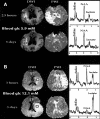A review of perioperative glucose control in the neurosurgical population
- PMID: 20144389
- PMCID: PMC2787035
- DOI: 10.1177/193229680900300615
A review of perioperative glucose control in the neurosurgical population
Abstract
Significant fluctuations in serum glucose levels accompany the stress response of surgery or acute injury and may be associated with vascular or neurologic morbidity. Maintenance of euglycemia with intensive insulin therapy (IIT) continues to be investigated as a therapeutic intervention to decrease morbidity associated with derangements in glucose metabolism. Hypoglycemia is a common side effect of IIT with potential for significant morbidity, especially in the neurologically injured patient. Differences in cerebral versus systemic glucose metabolism, the time course of cerebral response to injury, and heterogeneity of pathophysiology in neurosurgical patient populations are important to consider in evaluating the risks and benefits of IIT. While extremes of glucose levels are to be avoided, there are little data to support specific use of IIT for maintenance of euglycemia in the perioperative management of neurosurgical patients. Existing data are summarized and reviewed in this context.
Figures

Similar articles
-
Perioperative and critical illness dysglycemia--controlling the iceberg.J Diabetes Sci Technol. 2009 Nov 1;3(6):1288-91. doi: 10.1177/193229680900300608. J Diabetes Sci Technol. 2009. PMID: 20144382 Free PMC article. Review.
-
Reducing glycemic variability in intensive care unit patients: a new therapeutic target?J Diabetes Sci Technol. 2009 Nov 1;3(6):1302-8. doi: 10.1177/193229680900300610. J Diabetes Sci Technol. 2009. PMID: 20144384 Free PMC article. Review.
-
Blood glucose control in the trauma patient.J Diabetes Sci Technol. 2009 Nov 1;3(6):1373-6. doi: 10.1177/193229680900300617. J Diabetes Sci Technol. 2009. PMID: 20144391 Free PMC article. Review.
-
Perioperative glucose control in neurosurgical patients.Anesthesiol Res Pract. 2012;2012:690362. doi: 10.1155/2012/690362. Epub 2012 Feb 13. Anesthesiol Res Pract. 2012. PMID: 22400022 Free PMC article.
-
Glycemic control in the medical intensive care unit.J Diabetes Sci Technol. 2009 Nov 1;3(6):1330-41. doi: 10.1177/193229680900300613. J Diabetes Sci Technol. 2009. PMID: 20144387 Free PMC article. Review.
Cited by
-
Effect of sevoflurane versus desflurane on blood glucose level in patients undergoing intracranial neurosurgery: A randomised controlled study.Indian J Anaesth. 2022 Nov;66(11):769-775. doi: 10.4103/ija.ija_7_22. Epub 2022 Nov 18. Indian J Anaesth. 2022. PMID: 36590188 Free PMC article.
-
Outcomes of diabetic and nondiabetic patients undergoing general and vascular surgery.ISRN Surg. 2013 Dec 26;2013:963930. doi: 10.1155/2013/963930. eCollection 2013 Dec 26. ISRN Surg. 2013. PMID: 24455308 Free PMC article.
-
Intraoperative blood glucose management: impact of a real-time decision support system on adherence to institutional protocol.J Clin Monit Comput. 2016 Jun;30(3):301-12. doi: 10.1007/s10877-015-9718-3. Epub 2015 Jun 12. J Clin Monit Comput. 2016. PMID: 26067402
-
Glycemic instability of non-diabetic patients after spine surgery: a prospective cohort study.Eur Spine J. 2014 Nov;23(11):2455-61. doi: 10.1007/s00586-014-3489-2. Epub 2014 Aug 8. Eur Spine J. 2014. PMID: 25103953
-
Perioperative Stroke in a Patient Undergoing Noncardiac, Non-Neurosurgical Procedure: A Case Report.Cureus. 2020 Aug 5;12(8):e9570. doi: 10.7759/cureus.9570. Cureus. 2020. PMID: 32913687 Free PMC article.
References
-
- Baird TA, Parsons MW, Phanh T, Butcher KS, Desmond PM, Tress BM, Colman PG, Chambers BR, Davis SM. Persistent poststroke hyperglycemia is independently associated with infarct expansion and worse clinical outcome. Stroke. 2003;34(9):2208–2214. - PubMed
-
- Claassen J, Vu A, Kreiter KT, Kowalski RG, Du EY, Ostapkovich N, Fitzsimmons BF, Connolly ES, Mayer SA. Effect of acute physiologic derangements on outcome after subarachnoid hemorrhage. Crit Care Med. 2004;32(3):832–838. - PubMed
-
- Donnan GA, Levi C. Glucose and the ischaemic bratoo much of a good thing? Lancet Neurol. 2007;6(5):380–381. - PubMed
-
- Frontera JA, Fernandez A, Claassen J, Schmidt M, Schumacher HC, Wartenberg K, Temes R, Parra A, Ostapkovich ND, Mayer SA. Hyperglycemia after SAH: predictors, associated complications, and impact on outcome. Stroke. 2006;37(1):199–203. - PubMed
-
- Garg R, Chaudhuri A, Munschauer F, Dandona P. Hyperglycemia, insulin, and acute ischemic stroke: a mechanistic justification for a trial of insulin infusion therapy. Stroke. 2006;37(1):267–273. - PubMed
Publication types
MeSH terms
Substances
LinkOut - more resources
Full Text Sources
Medical

